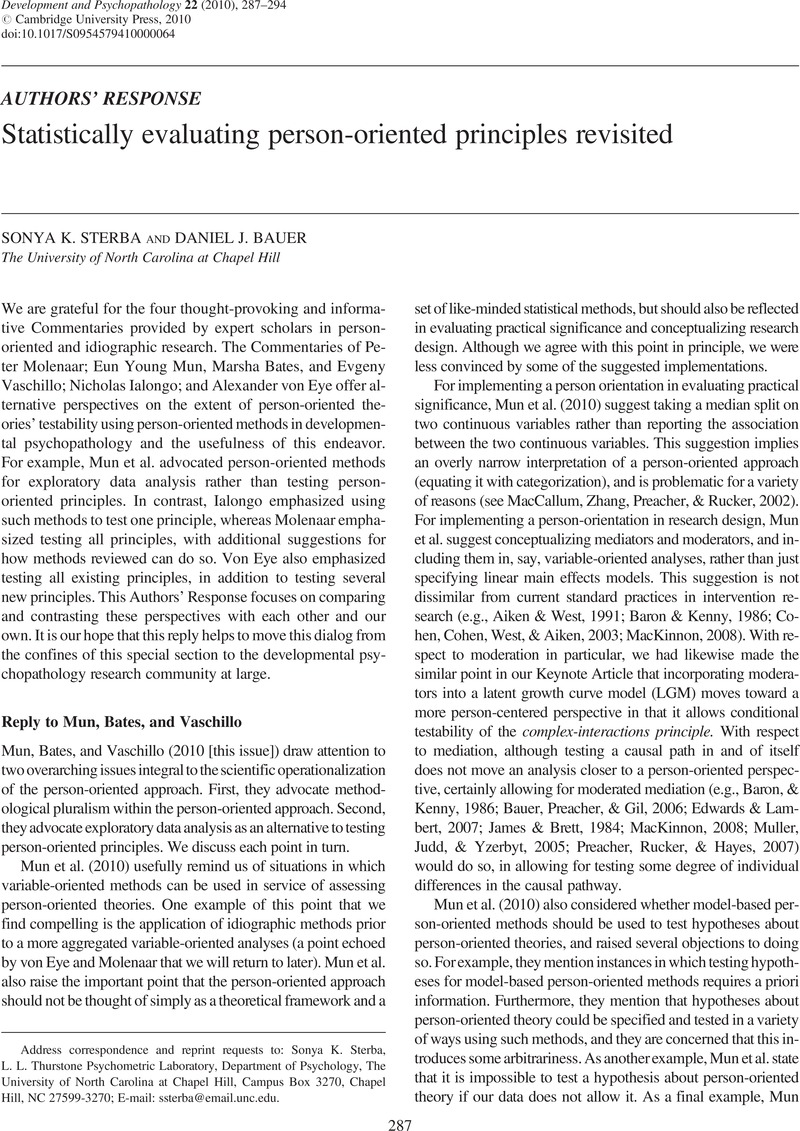Crossref Citations
This article has been cited by the following publications. This list is generated based on data provided by Crossref.
Snyder, Kate E.
and
Linnenbrink-Garcia, Lisa
2013.
A Developmental, Person-Centered Approach to Exploring Multiple Motivational Pathways in Gifted Underachievement.
Educational Psychologist,
Vol. 48,
Issue. 4,
p.
209.
Sterba, Sonya K.
and
Bauer, Daniel J.
2014.
Predictions of Individual Change Recovered With Latent Class or Random Coefficient Growth Models.
Structural Equation Modeling: A Multidisciplinary Journal,
Vol. 21,
Issue. 3,
p.
342.
Sterba, Sonya K.
2014.
Fitting Nonlinear Latent Growth Curve Models With Individually Varying Time Points.
Structural Equation Modeling: A Multidisciplinary Journal,
Vol. 21,
Issue. 4,
p.
630.
Sterba, Sonya K.
2014.
Handbook of Developmental Psychopathology.
p.
109.
Cummings, E. Mark
and
Valentino, Kristin
2015.
Handbook of Child Psychology and Developmental Science.
p.
1.
Molenaar, Peter C.M.
2015.
Author’s Response to Commentaries on: An Interpretation of Part of Gilbert Gottlieb’s Legacy: Developmental Systems Theory Contra Developmental Behavior Genetics.
International Journal of Developmental Science,
Vol. 9,
Issue. 1,
p.
23.
Cummings, E. Mark
Taylor, Laura K.
Merrilees, Christine E.
Goeke‐Morey, Marcie C.
and
Shirlow, Peter
2016.
Emotional insecurity in the family and community and youth delinquency in Northern Ireland: a person‐oriented analysis across five waves.
Journal of Child Psychology and Psychiatry,
Vol. 57,
Issue. 1,
p.
47.
Klijn, Sven L
Weijenberg, Matty P
Lemmens, Paul
van den Brandt, Piet A
and
Lima Passos, Valéria
2017.
Introducing the fit-criteria assessment plot – A visualisation tool to assist class enumeration in group-based trajectory modelling.
Statistical Methods in Medical Research,
Vol. 26,
Issue. 5,
p.
2424.
Cummings, E. Mark
Merrilees, Christine
Taylor, Laura K.
Goeke-Morey, Marcie
and
Shirlow, Peter
2017.
Emotional insecurity about the community: A dynamic, within-person mediator of child adjustment in contexts of political violence.
Development and Psychopathology,
Vol. 29,
Issue. 1,
p.
27.
Howard, Matt C.
and
Hoffman, Michael E.
2018.
Variable-Centered, Person-Centered, and Person-Specific Approaches.
Organizational Research Methods,
Vol. 21,
Issue. 4,
p.
846.
Kurz, A. Solomon
Johnson, Yelena L.
Kellum, Karen Kate
and
Wilson, Kelly G.
2019.
How can process-based researchers bridge the gap between individuals and groups? Discover the dynamic p-technique.
Journal of Contextual Behavioral Science,
Vol. 13,
Issue. ,
p.
60.
Molenaar, Peter C. M.
and
Beltz, Adriene M.
2020.
The Cambridge Handbook of Research Methods in Clinical Psychology.
p.
327.
2020.
The Cambridge Handbook of Research Methods in Clinical Psychology.
p.
299.
Luningham, Justin M.
Merrilees, Christine E.
Taylor, Laura K.
Goeke‐Morey, Marcie
Shirlow, Peter
Wentz, Bethany
and
Cummings, E. Mark
2021.
Relations Among Father's Presence, Family Conflict, and Adolescent Adjustment in Northern Ireland.
Child Development,
Vol. 92,
Issue. 3,
p.
904.



